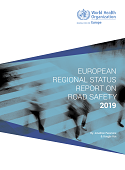European regional status report on road safety 2019

Download
2020, x + 133 pages
ISBN 978 92 890 5498 0
This publication is only available online.
Each year, over 80 000 lives are tragically lost on our roads. Whether the victims are young or older, passenger, driver or pedestrian, each person whose life is suddenly cut short is someone’s child, parent, partner or friend.
Every day, family and friends relive those moments when their loved ones were suddenly robbed of their lives.
Yet the truth is that every one of these deaths could have been prevented. Road-traffic crashes are not mere “accidents” or random acts. They are highly predictable, and therefore preventable.
This report shows that over 221 people are killed on roads every day in the WHO European Region. Thousands more are injured or disabled, with long-lasting effects.
The number of deaths and severe injuries from road crashes depends on where we live. People from the eastern part of our Region bear the highest burden of road-traffic mortality and morbidity. But regardless of where these tragedies occur, the grief and anguish are all too similar for families, with communities and wider society enduring the immense burden of economic and productivity loss.
Perhaps one of the most distressing facts in this report is that road-traffic crashes are the leading cause of all death for young children aged between 5 and 14 years. No child should die or be seriously injured on our roads while they walk, cycle or play.
Although the European Region is one of only two that have seen a reduction in road-traffic fatality, progress has not occurred at a pace fast enough to achieve the global target of halving road-traffic deaths by 2020. There are many reasons for this modest progress: rapid urbanization and motorization, poor safety standards and infrastructure, lack of strong enforcement, drivers being distracted or under the influence of drugs or alcohol, speeding and a failure to wear seat belts or helmets, and lack of access to timely post-crash care.
The United Nations Sustainable Development Goals towards 2030, together with the 12 voluntary global performance targets for road safety, provide renewed actions for halving road-traffic deaths. WHO’s extensive catalogue of normative and technical guidance for strengthening road safety is based on the recommended safe-systems approach to road safety. This approach recognizes that the human body is highly vulnerable to injury and that humans make mistakes, but that a set of complementary interventions, to create safer roads, safer vehicles, safer speeds and safer behaviour by road users, work together to accommodate error.
The European regional status report on road safety describes the progress made by governments in the Region. The report is based on a detailed survey of status reports on road safety completed by government appointed national data coordinators in 51 of 53 Member States of the Region.
The objective of the report is to provide intersectoral and interdisciplinary policy-makers, practitioners and advocates with the information and guidance needed to continue momentum for the safe-system approach for road safety and ensure that families are spared from the unimaginable suffering of losing a loved one or living with the trauma and disability caused by these devastating and life-altering events.
“With 10 people killed on Regional roads every hour, road safety is an unfinished agenda in Europe” says Dr Hans Henri P. Kluge, WHO Regional Director for Europe. “We do not accept such tragic outcomes in any other form of transport, yet in many countries these outcomes are still labelled “accidents” and put down to fate.”



